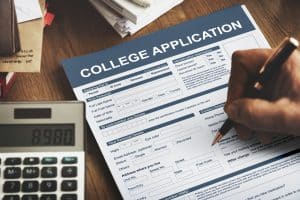UCLA Regular Decision Notification Date Class of 2028
UCLA’s Regular Decision notification date for the Class of 2028 is an essential moment for thousands of applicants. The journey to college is filled with anticipation and pivotal moments, one of the most significant being the day when universities announce their admissions decisions.
For aspiring Bruins, the UCLA regular decision notification date symbolizes the culmination of hard work and the start of a new chapter. This blog aims to demystify the process and provide crucial information for applicants eagerly awaiting their results from the University of California, Los Angeles.
UCLA Regular Decision Notification Date Class of 2028
As a student who applied for the regular decision at UCLA, you might feel a mix of excitement and anxiety as the notification date approaches. This period isn’t just about getting into college; it’s about starting a new chapter in your life, possibly in a new city, filled with unique challenges and opportunities. Knowing UCLA’s specific regular decision date is crucial, as it helps you and your family plan for the future and prepare mentally for the next steps, whatever they may be.
When Does UCLA Regular Decision Come Out?
UCLA plans to announce its regular decision for the Class of 2028 in late March. This date aligns with the university’s historical pattern, offering you a predictable timeline. However, you should remember that this date can slightly vary each year. The number of applications, administrative processes, and global events can influence the exact timing.
For example, years with exceptionally high application numbers might see slight delays. Similarly, university policy changes or unexpected events like global health crises can impact these dates. So, while late March is a reliable timeframe, you should stay flexible and keep an eye on UCLA’s official communications for any updates.
What Time Does UCLA Regular Decision Come Out?
Currently, UCLA hasn’t specified an exact time for releasing its regular decision notifications. This lack of a specific time is typical for universities. The decision-release process involves complex logistics, ensuring that systems can handle the high volume of traffic as students log in to check their statuses.
Without a set time, you should periodically check your email and the UCLA admissions portal throughout the day. Universities often release decisions during regular business hours, but this isn’t a strict rule. There have been instances where decisions came out in the evening or late at night.
This uncertainty underlines the importance of patience and maintaining a balanced approach. Constantly refreshing the portal or anxiously waiting for an email can be stressful. Setting regular intervals to check for updates while engaging in other activities can help manage any anxiety. It’s also wise to discuss plans with your family and school counselors, so you’re ready to act once the decision arrives.
The exact timing of UCLA’s regular decision notification for the class of 2028 within the late March frame remains uncertain. Stay informed, remain adaptable, and use this waiting period to prepare for all possible outcomes. No matter the decision, it’s an important learning experience and a significant step in your higher education journey.
How Does UCLA Notify Acceptance?
Gaining insight into how UCLA notifies students of acceptance encompasses understanding both the timing and methods of communication. For countless students applying to this prestigious university, each step of the application process blends hope, effort, and anticipation. As decision day nears, it’s crucial for you to understand how UCLA communicates its admissions decisions.
UCLA typically notifies you of your admission status through their online portal and via email. These quick and direct methods ensure that you receive your results as soon as UCLA releases them. On the big day, you should frequently check your email and the UCLA admissions portal.
UCLA’s emails usually contain essential information about the decision and the next steps for accepted students. The online portal often provides a more detailed view of your admission status, including financial aid, housing, and enrollment procedures.
Notifications: Acceptances, Waitlist Offers, and Rejections
Acceptance is, of course, the most desired outcome. An acceptance email from UCLA typically includes congratulations and information about the next steps, such as how to accept the offer, decision-making deadlines, and details about orientation and registration. As an accepted student, you usually have a set period to confirm your acceptance and complete any required paperwork or deposits.
Receiving a waitlist offer, while not an outright acceptance, still keeps your admission chances alive. If UCLA places you on the waitlist, you will usually receive instructions on how to accept a place on the waitlist and any additional steps you can take to strengthen your application. This might involve submitting updated grades, new test scores, or additional letters of recommendation.
Although receiving a rejection can be difficult, it is a reality of the competitive college admissions process. UCLA’s rejection notices are typically concise and respectful, often including words of encouragement and sometimes resources for exploring other options or reapplying in the future.
The Comprehensive Admissions Process
UCLA’s admissions process is holistic, considering various aspects of your application to make a well-rounded decision. This approach means that UCLA looks beyond academic scores, evaluating your personal essays, extracurricular activities, leadership experiences, and recommendations. The goal is to select students who will excel academically and contribute to the campus community in diverse and meaningful ways.
You should remember that UCLA receives a large number of applications each year. The high volume, combined with the holistic review, means that UCLA makes its decisions after a thorough consideration of each application. While grades and test scores are important, UCLA also values your personal achievements and the unique qualities you can bring to the university community.
UCLA’s acceptance notification process efficiently combines efficiency and thorough evaluation. By understanding this process, you can better prepare for various outcomes and plan your next steps accordingly, whether that means celebrating an acceptance, considering a waitlist offer, or moving forward after a rejection.
What to Expect After Receiving UCLA’s Decision
Once you are informed of the UCLA Regular Decision notification date for the Class of 2028, it’s essential to brace yourself for the array of emotions that may follow. Whether it’s joy from acceptance, uncertainty from waitlisting, or the disappointment of rejection, each outcome demands an informed and thoughtful response.
It’s important to understand these outcomes and know the best ways to move forward. Acceptance, waitlisting, or rejection—each requires a unique response and mindset. Let’s go through a detailed guide on navigating post-decision scenarios at UCLA.
Acceptance: Embarking on Your Bruin Journey
Congratulations if UCLA sends you an acceptance letter! This is a tremendous accomplishment. However, your journey doesn’t end here. You must make crucial decisions and prepare for college life. First, confirm your admission by the deadline, usually by paying a deposit to secure your spot.
Next, focus on UCLA student logistics, like housing. UCLA offers a range of housing options, from traditional dormitories to apartments. Consider your preferences and budget when choosing. Remember, housing applications are competitive, so apply early.
Orientation is another vital step. UCLA’s orientation sessions provide information on academics, campus life, and social activities. They’re also where you’ll register for your first-quarter classes, so attending one that fits your schedule is crucial.
Waitlist: Navigating Uncertainty
If UCLA waitlists you, it might feel like you’re in limbo, but all hope is not lost. First, decide whether to remain on the waitlist, especially if UCLA is your top choice. To stay on the list, follow UCLA’s instructions.
While waitlisted, keep UCLA updated with any new achievements or improvements in your academic profile. This could include new leadership roles, awards, better grades, or test scores. But remember to adhere to UCLA’s guidelines for sending updates.
Being waitlisted isn’t just a waiting game. Look into other options. If you have acceptances from other institutions, consider securing a spot as a backup. This ensures you have a clear path forward, regardless of UCLA’s final decision.
Rejection: Finding Alternative Paths
A rejection from UCLA can be tough, but it’s important to maintain perspective. College admissions are highly competitive. A rejection doesn’t define your worth or potential.
First, give yourself time to process the disappointment. Then, focus on other opportunities. If other colleges have accepted you, revisit those options with an open mind. Each university offers unique experiences and growth opportunities.
Consider transferring in the future. Many students start at another university or community college and transfer to their dream school later. If this interests you, research UCLA’s transfer requirements and focus on maintaining a strong academic record and engaging in meaningful activities.
Alternatively, a gap year can be a time for personal growth, skill-building, and real-world experience. This could strengthen your application if you decide to reapply to UCLA or other universities later.
No matter what decision you receive from UCLA, there are plenty of ways to shape your academic and professional journey. Each decision opens different pathways, and it’s all about making the most of the opportunities available to you.
Understanding UCLA’s Admission Criteria
Receiving your admissions decision from UCLA marks a pivotal moment in your academic journey, especially after becoming familiar with the UCLA Regular Decision notification date for the Class of 2028. It’s crucial to realize that gaining admission to UCLA, a prestigious university known for its rigorous selection criteria, demands more than exemplary grades.
UCLA assesses applicants holistically, considering a range of factors to ensure they select students who are academically capable and bring diverse perspectives and talents to their campus. Let’s explore what UCLA values in applicants, providing insights into how you can strengthen your application.
Academic Excellence
UCLA significantly emphasizes academic performance, including your GPA, the rigor of your high school courses, and standardized test scores, if submitted. High grades in advanced courses like AP, IB, or honors classes demonstrate your ability to excel in challenging academic settings. However, UCLA also looks at the context of your academic achievements. They consider the educational opportunities available to you and any hardships that might have impacted your academic journey.
Extracurricular Involvement
UCLA values commitment and leadership in extracurricular activities outside the classroom, be it in sports, the arts, community service, or clubs. The key is depth over breadth. UCLA prefers seeing sustained involvement and progression in a few activities, showcasing your passion and dedication, over a long list of unconnected engagements. This part of your application offers a glimpse into who you are, what matters to you, and how you might contribute to the UCLA community.
Personal Essays
Your personal essays are a crucial part of your UCLA application. This is your chance to speak directly to the admissions committee and give them insight into your personality, experiences, and aspirations. UCLA’s prompts aim to understand your character, how you handle challenges, and what you could bring to their campus. A compelling essay is both authentic and reflective, showing a clear sense of self-awareness. It’s not just about showcasing your achievements; it’s about illustrating your potential to grow, contribute, and benefit from a UCLA education.
Recommendation Letters
Recommendation letters give the admissions committee external perspectives on your academic abilities and personal qualities. UCLA looks for letters that provide detailed insights into your character, work ethic, and contributions to your school or community. The best recommendations come from teachers, counselors, or mentors who know you well and can speak to your strengths and potential with specific examples. These letters complement your academic record and extracurricular activities, giving a fuller picture of you as a well-rounded candidate.
UCLA’s admissions criteria are designed to identify students who are not just academically adept but also demonstrate qualities like leadership, resilience, and a genuine interest in contributing to the campus and broader community. By understanding these criteria and thoughtfully preparing each aspect of your application, you present yourself as a strong candidate for UCLA.
Tips for Navigating College Admissions Results
Navigating college admissions results can be as challenging as the application process itself. The moment of truth arrives in various forms: acceptance, waitlist, or rejection. Each outcome requires a thoughtful approach and an understanding of what lies ahead. Let’s take a look at how to handle each of these outcomes effectively.
Interpreting Decisions
It’s crucial to understand the implications of each decision type. An acceptance is an invitation to join the university community, recognizing your hard work and suitability for the institution. Meanwhile, a waitlist position means you still have a chance for admission. You should promptly respond to a waitlist offer and express your continued interest.
Some universities consider this a factor in their final decisions. While a rejection can be disappointing, don’t see it as a measure of your worth or potential. Each university has unique selection criteria, often based on factors like institutional needs and applicant pools. Remember, rejection from one school doesn’t limit your success at another.
Responding to Offers
If you receive an acceptance, review the offer thoroughly. Assess the financial aid package and understand the costs. If you’re concerned about finances, don’t hesitate to reach out to the financial aid office to discuss options or appeal for more aid. Moreover, research the specifics of the program you’ve been admitted to. Look into the curriculum, faculty, and opportunities for research or internships. Also, explore the university’s culture and community.
Try connecting with current students or alumni for firsthand insights into campus life. For those waitlisted, keep your options open. You may accept another institution’s offer as a backup since waitlist admissions are uncertain. Make sure to follow any instructions from the university, like submitting additional information or a letter of continued interest.
Planning Next Steps
Once accepted, it’s time to start planning your college journey. Explore housing options, both on and off-campus. Begin class registration and familiarize yourself with the academic calendar. Also, consider attending orientation programs, as they help you acclimate to university life, meet peers, and understand campus resources. If you didn’t receive the news you hoped for, explore alternative paths.
Community colleges are a great starting point, offering the chance to transfer to a four-year university later. Gap-year programs can provide valuable life experiences and clarity on your academic and career goals. Also, consider other universities with rolling admissions or later application deadlines. Remember, multiple pathways can lead to achieving your educational and career objectives, and sometimes a detour leads to unexpected and rewarding destinations.
By understanding and effectively navigating the different outcomes of the college admissions process, you can make informed decisions and set yourself up for success in your academic and personal lives.
Maximizing Your Chances for Future Applications
As you mark your calendar with UCLA’s Regular Decision notification date for the Class of 2028, it’s equally essential to grasp the strategies for fortifying your college application. Building a robust profile involves more than just academic excellence; it includes academic achievements, leadership roles, extracurricular involvement, and effective personal statement writing. Let’s explore how you can enhance your chances of standing out in future applications to prestigious universities like UCLA.
Enhancing your academic profile
Your academic record plays a key role in your college application. Achieving top grades is important, but showing your intellectual curiosity and ability to handle challenging coursework is equally vital. Here’s how you can bolster your academic profile:
- Take rigorous courses: Enroll in Advanced Placement (AP) or International Baccalaureate (IB) courses if they’re available. These classes show your eagerness to tackle challenging material.
- Maintain consistent grades: Strive for steady improvement in your grades—universities like UCLA value students who consistently perform well or show marked improvement over time.
- Engage in academic competitions: Get involved in science fairs, math olympiads, or writing contests. These activities highlight your passion for and expertise in a subject.
- Seek academic enrichment: Participate in summer programs, workshops, or online courses in your areas of interest. These experiences deepen your knowledge and demonstrate your commitment to learning.
Building leadership and extracurricular activities
Colleges look for students who contribute to their community and have leadership potential. To strengthen this aspect of your application:
- Pursue your passions: Focus on extracurricular activities that align with your interests. Depth in a few activities is often more impactful than participation in many.
- Take on leadership roles: Seek roles like captain of a sports team, president of a club, or organizer of a volunteer project. These positions show your initiative and responsibility.
- Community service: Get involved in community service projects. Tailor these experiences to your interests or intended field of study.
- Document your journey: Keep a record of your extracurricular activities, noting the roles you held and the impact you made. This information will be valuable when you apply to colleges.
Crafting compelling personal statements
The personal statement is an opportunity to speak directly to admissions officers and should reflect who you are beyond grades and test scores.
- Be authentic: Write in your own voice and stay true to your experiences. Authenticity is more appealing than trying to fit a perceived ideal applicant profile.
- Showcase growth and reflection: Share experiences that have shaped you. Colleges are interested in your journey, the challenges you’ve overcome, and your learning.
- Connect your story to your goals: Explain how your experiences have influenced your academic and career aspirations. This connection helps admissions officers understand how you fit into their campus community.
- Seek feedback: Ask teachers, counselors, or mentors to review your essays. Their constructive feedback can refine your narrative and ensure clarity.
Building a strong college application is a multifaceted process. It requires not just academic excellence but also leadership, community involvement, and effective communication of your story. By focusing on these areas, you’ll enhance your application and develop skills beneficial beyond the college admissions process.
Navigating the Financial Aid Process at UCLA
Understanding the financial aid process at UCLA, especially as the Class of 2028 approaches the regular decision notification date, is crucial for students relying on assistance to fund their education. The University of California, Los Angeles, offers a diverse array of financial aid options, including grants, scholarships, loans, and work-study programs.
These options are designed to make higher education accessible to students from various economic backgrounds. It’s essential to approach this process with diligence, utilizing all available resources and adhering to deadlines, to maximize your financial aid potential.
Understanding UCLA’s Financial Aid Offerings
UCLA’s financial aid program is extensive, meeting the diverse needs of its student body. Familiarize yourself with the different types of financial aid available. Grants, like the Pell Grant and Cal Grant, do not require repayment and are typically need-based. Scholarships, another key form of aid, can be based on merit or need and come from UCLA, private organizations, or community groups.
Loans, both federal and private, are also available, but you should understand their terms, as they require repayment with interest after graduation. UCLA’s work-study program offers part-time jobs related to your field of study, providing financial assistance and valuable work experience.
Applying for Financial Aid at UCLA
The financial aid application process at UCLA starts with completing the Free Application for Federal Student Aid (FAFSA) or the California Dream Act Application, based on your residency status. These applications help UCLA determine your financial needs and eligibility for various types of aid. Submit these applications as early as possible, ideally right after they open on October 1st, as some funds are first-come, first-served.
After you submit your FAFSA or Dream Act Application, UCLA will send you a financial aid offer detailing the types and amounts of aid you’re eligible for. Carefully review this offer and understand each component. If you have questions, UCLA’s Financial Aid and Scholarships office offers personalized advice and assistance.
Maximizing Your Financial Aid at UCLA
To maximize your financial aid, actively search for scholarships you’re eligible for. UCLA’s scholarship resource center can help you find opportunities. Additionally, scholarships from community organizations, companies, and foundations can supplement your financial aid package.
Understand the criteria to maintain your financial aid, typically involving maintaining a certain GPA and completing a minimum number of units each quarter. Knowing these requirements ensures you stay eligible for financial aid at UCLA.
Beyond Financial Aid: Budgeting and Money Management
While financial aid covers a significant portion of college expenses, effective budgeting and money management are crucial. Develop a budget including tuition, housing, books, and living expenses to understand your financial situation. UCLA offers resources and workshops on financial literacy to help you manage your finances responsibly.
Navigating UCLA’s financial aid process is a critical part of your college preparation. By familiarizing yourself with different types of aid, adhering to application processes and deadlines, seeking scholarship opportunities, and managing your finances wisely, you can make attending UCLA a financially achievable goal. Remember, UCLA’s Financial Aid and Scholarships office is there to assist you, ensuring financial barriers don’t hinder your academic aspirations.
Conclusion
Your journey through the challenging college admissions process, especially when waiting for UCLA’s regular decision, marks a significant step in your academic and personal growth. Applying to a university like UCLA demands more than academic prowess; it requires showing character, passion, and perseverance. These qualities, integral to your identity, continue to shape your future, no matter the outcome.
Whether UCLA’s decision is an acceptance, a waitlist spot, or a rejection, each brings its own lessons and opportunities. Acceptance is a validation of your efforts, opening doors to new experiences. Being waitlisted tests your resilience, encouraging introspection. A rejection, though initially disappointing, is not an end but a redirection to paths possibly better suited for your unique journey.
Every application you submit narrates your life’s story, highlighting your achievements, dreams, and aspirations. Each college decision is a step toward your future success. Remember, your journey doesn’t end with UCLA’s decision; it’s merely a part of your evolving story, shaped by every decision and effort. As you move forward, use the lessons learned, strengths developed, and resilience built to carve your own path to success, wherever it may lead.











































